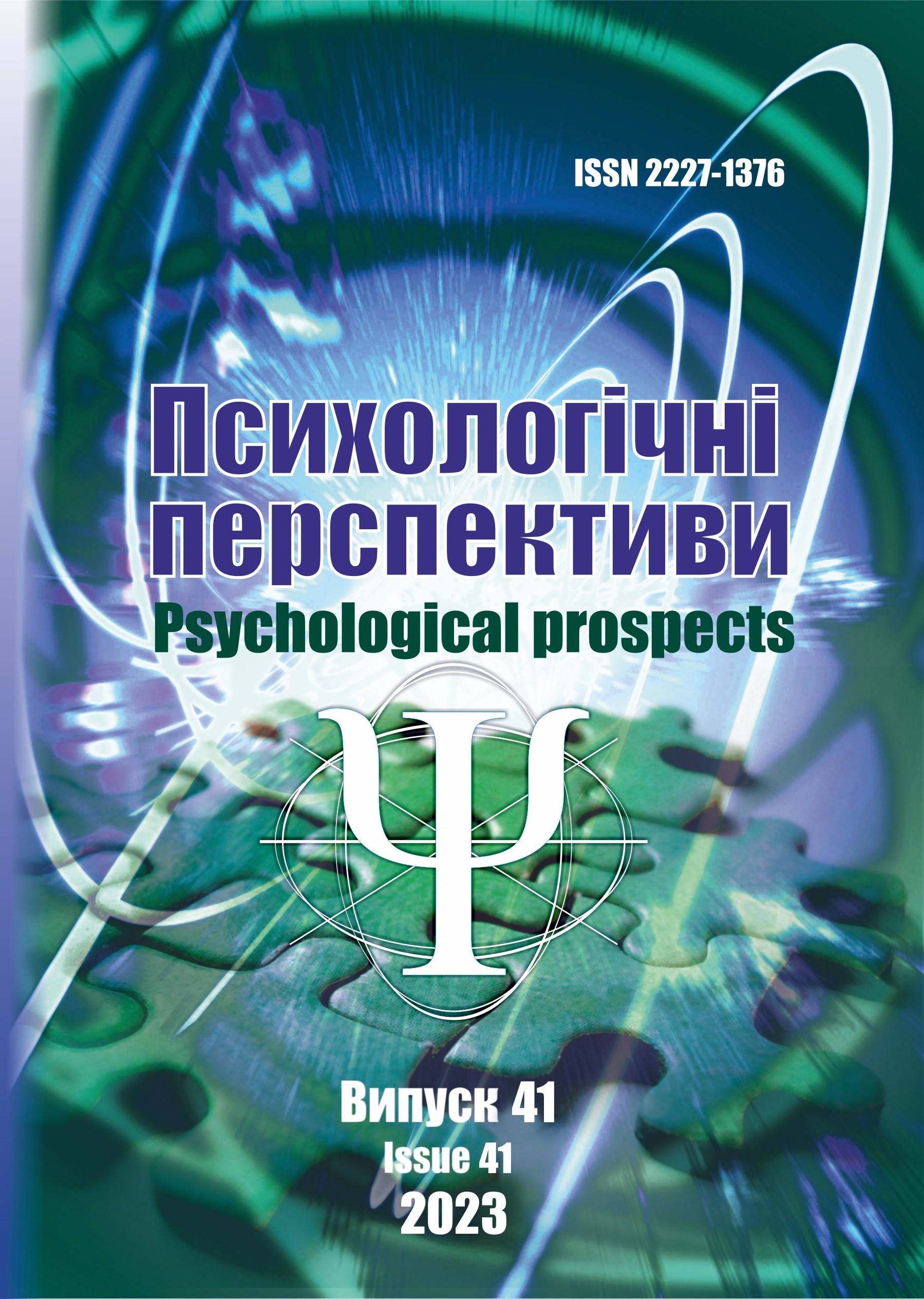LIFE LANDSCAPES OF THE UKRAINIAN CIVILIANS IN THE SPACE OF THE WAR
DOI:
https://doi.org/10.29038/2227-1376-2023-41-tytKeywords:
war experiences, Ukrainian population, gender and age landscape features, descriptive and interpretative narratives’ analyses, multiple correspondence analysesAbstract
Purpose. The purpose is to identify widespread life landscapes with their value-sense and vector configuration in the context of war.
Methods. The method used is the conceptualization of war-experience in 169 Ukrainian civilians’ narratives with a descriptive, interpretative analysis, and multiple correspondence analysis (MCA) conducted. The clarification of values, communication, professional activity, plans regarding future allowed to determine common landscapes.
Results. The three main types of life landscapes were defined: the landscape of service with the dominant context of volunteering, selfless help to the army (27,8%), the existential landscape with the dominant context of suffering, surviving (24,3 %) and the landscape of care with the dominant context of saving family, partnership (23,7 %). The less common is the landscape of self-development with the context of personal growth and the societal landscape with economic and political contexts. The existential landscape is the most common among young respondents; the landscape of care – among the group of early maturity; the landscape of service – among the group of middle and late maturity. Gender differences are as follows: in women, the landscapes of service, care, and existential are almost equally represented; in men, the landscape of service is the most popular; next, come the existential and societal landscapes. Dimensions of activity-passivity and narrowness-broadness were found out to be the most significant in multiple correspondence analysis.
Conclusions. The study offers an explanation of war experience through the prism of personal life landscapes. The determination of widespread landscapes with age and gender characteristics enables the targeted development of social and psychological support for victims.
References
Blasius, J., Lebaron, F., Le Roux, B., Schmitz, A. (2019). Empirical Investigations of Social Space. https://doi.org/10.1007/978-3-030-15387-8 DOI: https://doi.org/10.1007/978-3-030-15387-8
Bourdieu, P. (1985). The social space and the genesis of groups. Theory and Society, 14(6). https://doi.org/10.1007/bf00174048 DOI: https://doi.org/10.1007/BF00174048
Bruce, A., Beuthin, R., Shields, L., Molzahn, A., & Schick-Makaroff, K. (2016). Narrative Research Evolving: Evolving Through Narrative Research. International Journal of Qualitative Methods, 15 (1). https://doi.org/10.1177/1609406916659292 DOI: https://doi.org/10.1177/1609406916659292
Jawaid, A., Gomolka, M., & Timmer, A. (2022). Neuroscience of trauma and the Russian invasion of Ukraine. Nature Human Behaviour, 6(6), 748–749. https://doi.org/10.1038/s41562-022-01344-4 DOI: https://doi.org/10.1038/s41562-022-01344-4
Jones, L., & Kafetsios, K. (2002) Assessing adolescent mental health in war-affected societies: The significance of symptoms. Child Abuse & Neglect,. 26 (10), 1059–1080. https://doi.org/10.1016/S0145-2134(02)00381-2 DOI: https://doi.org/10.1016/S0145-2134(02)00381-2
Kokun, O. (2022). The Ukrainian Population’s War Losses and Their Psychological and Physical Health. Journal of Loss and Trauma, 1–14. https://doi.org/10.1080/15325024.2022.2136612 DOI: https://doi.org/10.1080/15325024.2022.2136612
Kurapov, A., Pavlenko, V., Drozdov, A., Bezliudna, V., Reznik, A., & Isralowitz, R. (2022). Toward an Understanding of the Russian-Ukrainian War Impact on University Students and Personnel. Journal of Loss and Trauma, 1–8. https://doi.org/10.1080/15325024.2022.2084838 DOI: https://doi.org/10.1080/15325024.2022.2084838
Lebaron, F. (2010). European Central Bank leaders in the global space of central bankers: A Geometric Data Analysis approach. French Politics, 8(3), 294–320. https://doi.org/10.1057/fp.2010.15 DOI: https://doi.org/10.1057/fp.2010.15
Lebaron, F. (2021). Geometric Data Analysis as a Tool for Reflexivity. Historical Social Research, 46(2), 126-154. https://doi.org/10.12759/hsr.46.2021.2.126-154
Le Roux, B., & Rouanet, H. (2009). Multiple Correspondence Analysis (Quantitative Applications in the Social Sciences) (1st ed.). SAGE Publications, Inc. DOI: https://doi.org/10.4135/9781412993906
Luno, J. A., Louwerse, M. M., & Beck, J. G. (2013). Tell Us Your Story: Investigating the Linguistic Features of Trauma Narrative. Cognitive Science, 35(35), 2955–2960. http://csjarchive.cogsci.rpi.edu/Proceedings/2013/papers/0529/paper0529.pdf
Munjiza, J., Britvic D., Radman M., Crawford M. (2017). Severe war-related trauma and personality pathology: a case-control study. BMC Psychiatry, 17, 100. https://doi.org/10.1186/s12888-017-1269-3 DOI: https://doi.org/10.1186/s12888-017-1269-3
Parkes, R., & McGarvey-Gill, C. (2022). The Ground Fell Away: An Autobiographical Study of Surviving a Fall from Height. Journal of Loss and Trauma, 1–15. https://doi.org/10.1080/15325024.2022.2119174 DOI: https://doi.org/10.1080/15325024.2022.2119174
Rodden-Aubut, S., & Tracey, J. (2020). An Uphill Battle: A Qualitative Case Study of Growth Experiences of Veterans in the Canadian Armed Forces. Military Behavioral Health, 9(1), 46–54. https://doi.org/10.1080/21635781.2020.1784324 DOI: https://doi.org/10.1080/21635781.2020.1784324
Smith, J. A., & Osborn, M. (2015). Interpretative phenomenological analysis as a useful methodology for research on the lived experience of pain. British Journal of Pain, 9(1), 41–42. https://doi.org/10.1177/2049463714541642 DOI: https://doi.org/10.1177/2049463714541642
Tytarenko, T. M. (2020). Posttravmatychne zhyttyetvorennya: sposoby dosyahnennya psykholohichnoho blahopoluchchya. [Post-traumatic life designing: ways to achieve psychological well-being]. Imeks-LTD.
Warczok, T., & Beyer, S. (2021). The logic of knowledge production: Power structures and symbolic divisions in the elite field of American sociology. Poetics, 87, 101531. https://doi.org/10.1016/j.poetic.2021.101531 DOI: https://doi.org/10.1016/j.poetic.2021.101531
Zasiekina, L., Khvorost, Kh., & Zasiekina, D. (2018). Traumatic Narrative in Psycholinguistic Study Dimension. Psycholinguistics, 23(1). https://doi.org/10.5281/zenodo.1211097
Zięba, M., Wiecheć, K., Biegańska-Banaś, J., & Mieleszczenko-Kowszewicz, W. (2019). Coexistence of Post-traumatic Growth and Post-traumatic Depreciation in the Aftermath of Trauma: Qualitative and Quantitative Narrative Analysis. Frontiers in Psychology, 10. https://doi.org/10.3389/fpsyg.2019.00687 DOI: https://doi.org/10.3389/fpsyg.2019.00687
Downloads
Published
Issue
Section
License
Copyright (c) 2023 Tytarenko T., Gromova H.

This work is licensed under a Creative Commons Attribution-NonCommercial 4.0 International License.






